Canadian History: Examining Law, Justice, and Societal Impact
VerifiedAdded on 2023/04/06
|6
|1317
|374
Essay
AI Summary
This essay delves into Canadian history since Confederation, highlighting biases within the legal and justice systems. It examines how women were deprived of basic rights, particularly immigrant women facing nationality-based discrimination. The analysis includes discussions of gender and class biases in crime representation, using the Melina Masse murder case as an example. Contrasting viewpoints are presented, exploring the neglect of inclusiveness and freedom in early Canadian governance versus individual rights. The essay concludes that the law and justice system historically favored the powerful, negatively impacting Canadian society. Desklib provides a platform to access this essay and other study resources.
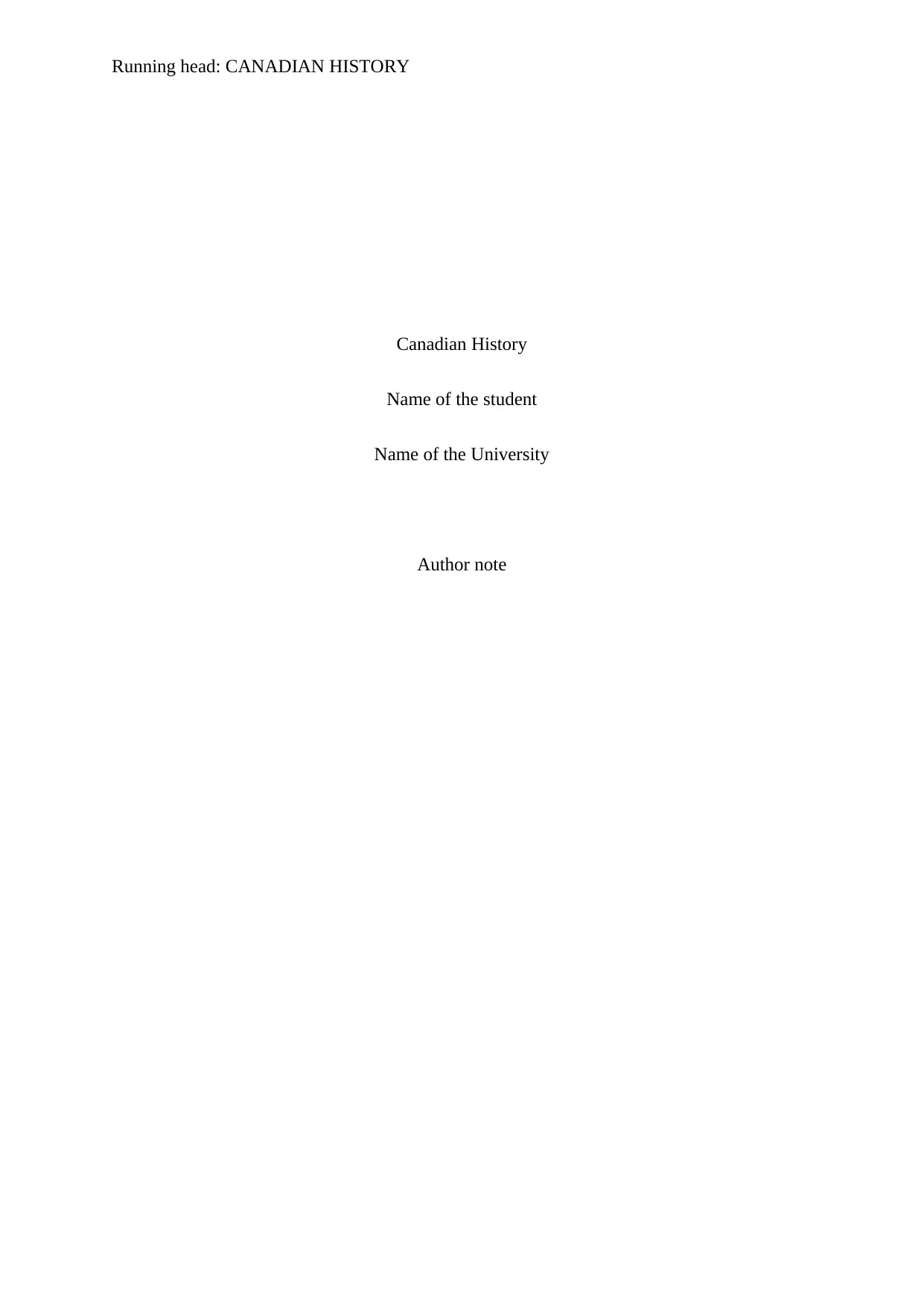
Running head: CANADIAN HISTORY
Canadian History
Name of the student
Name of the University
Author note
Canadian History
Name of the student
Name of the University
Author note
Paraphrase This Document
Need a fresh take? Get an instant paraphrase of this document with our AI Paraphraser
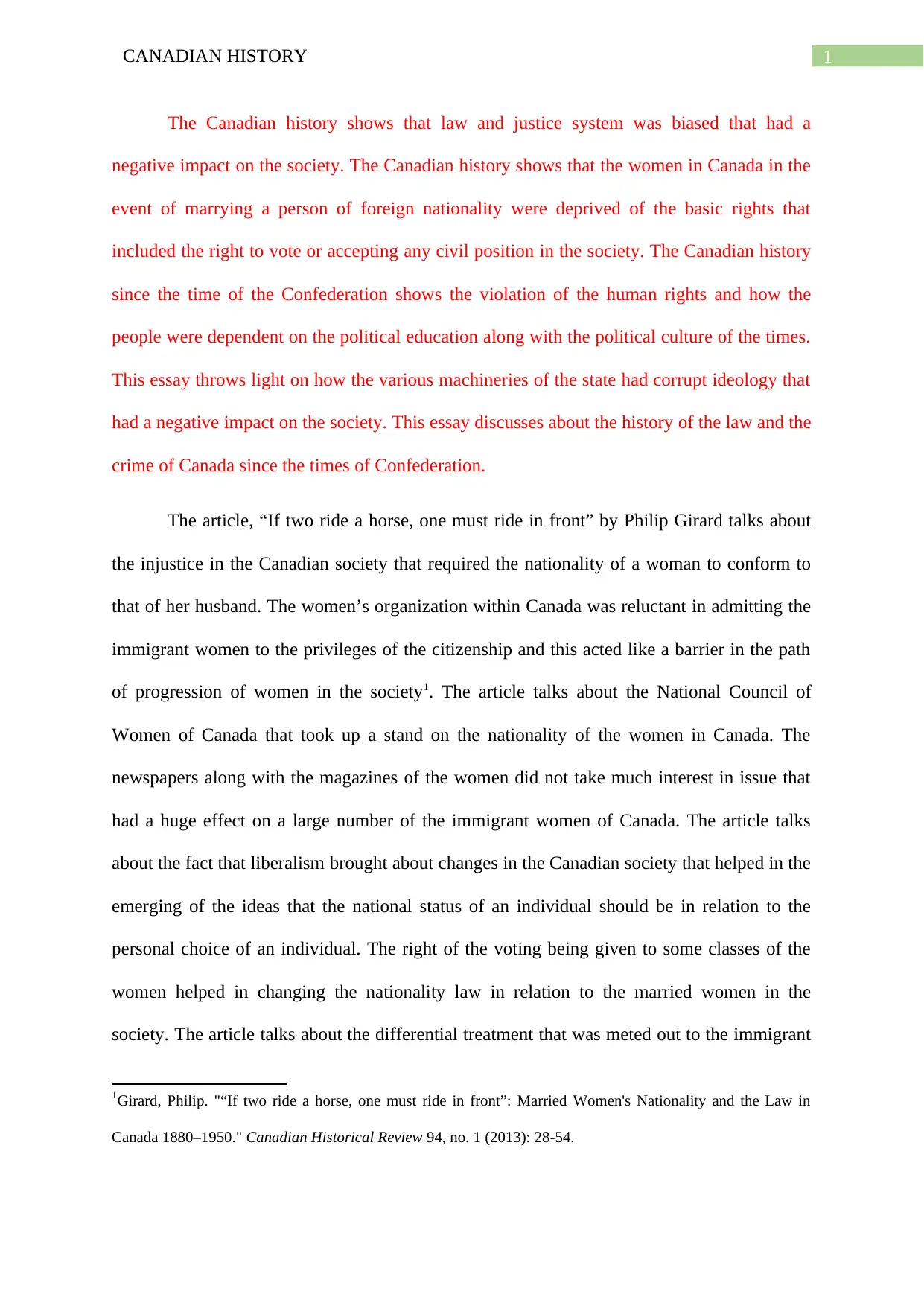
1CANADIAN HISTORY
The Canadian history shows that law and justice system was biased that had a
negative impact on the society. The Canadian history shows that the women in Canada in the
event of marrying a person of foreign nationality were deprived of the basic rights that
included the right to vote or accepting any civil position in the society. The Canadian history
since the time of the Confederation shows the violation of the human rights and how the
people were dependent on the political education along with the political culture of the times.
This essay throws light on how the various machineries of the state had corrupt ideology that
had a negative impact on the society. This essay discusses about the history of the law and the
crime of Canada since the times of Confederation.
The article, “If two ride a horse, one must ride in front” by Philip Girard talks about
the injustice in the Canadian society that required the nationality of a woman to conform to
that of her husband. The women’s organization within Canada was reluctant in admitting the
immigrant women to the privileges of the citizenship and this acted like a barrier in the path
of progression of women in the society1. The article talks about the National Council of
Women of Canada that took up a stand on the nationality of the women in Canada. The
newspapers along with the magazines of the women did not take much interest in issue that
had a huge effect on a large number of the immigrant women of Canada. The article talks
about the fact that liberalism brought about changes in the Canadian society that helped in the
emerging of the ideas that the national status of an individual should be in relation to the
personal choice of an individual. The right of the voting being given to some classes of the
women helped in changing the nationality law in relation to the married women in the
society. The article talks about the differential treatment that was meted out to the immigrant
1Girard, Philip. "“If two ride a horse, one must ride in front”: Married Women's Nationality and the Law in
Canada 1880–1950." Canadian Historical Review 94, no. 1 (2013): 28-54.
The Canadian history shows that law and justice system was biased that had a
negative impact on the society. The Canadian history shows that the women in Canada in the
event of marrying a person of foreign nationality were deprived of the basic rights that
included the right to vote or accepting any civil position in the society. The Canadian history
since the time of the Confederation shows the violation of the human rights and how the
people were dependent on the political education along with the political culture of the times.
This essay throws light on how the various machineries of the state had corrupt ideology that
had a negative impact on the society. This essay discusses about the history of the law and the
crime of Canada since the times of Confederation.
The article, “If two ride a horse, one must ride in front” by Philip Girard talks about
the injustice in the Canadian society that required the nationality of a woman to conform to
that of her husband. The women’s organization within Canada was reluctant in admitting the
immigrant women to the privileges of the citizenship and this acted like a barrier in the path
of progression of women in the society1. The article talks about the National Council of
Women of Canada that took up a stand on the nationality of the women in Canada. The
newspapers along with the magazines of the women did not take much interest in issue that
had a huge effect on a large number of the immigrant women of Canada. The article talks
about the fact that liberalism brought about changes in the Canadian society that helped in the
emerging of the ideas that the national status of an individual should be in relation to the
personal choice of an individual. The right of the voting being given to some classes of the
women helped in changing the nationality law in relation to the married women in the
society. The article talks about the differential treatment that was meted out to the immigrant
1Girard, Philip. "“If two ride a horse, one must ride in front”: Married Women's Nationality and the Law in
Canada 1880–1950." Canadian Historical Review 94, no. 1 (2013): 28-54.
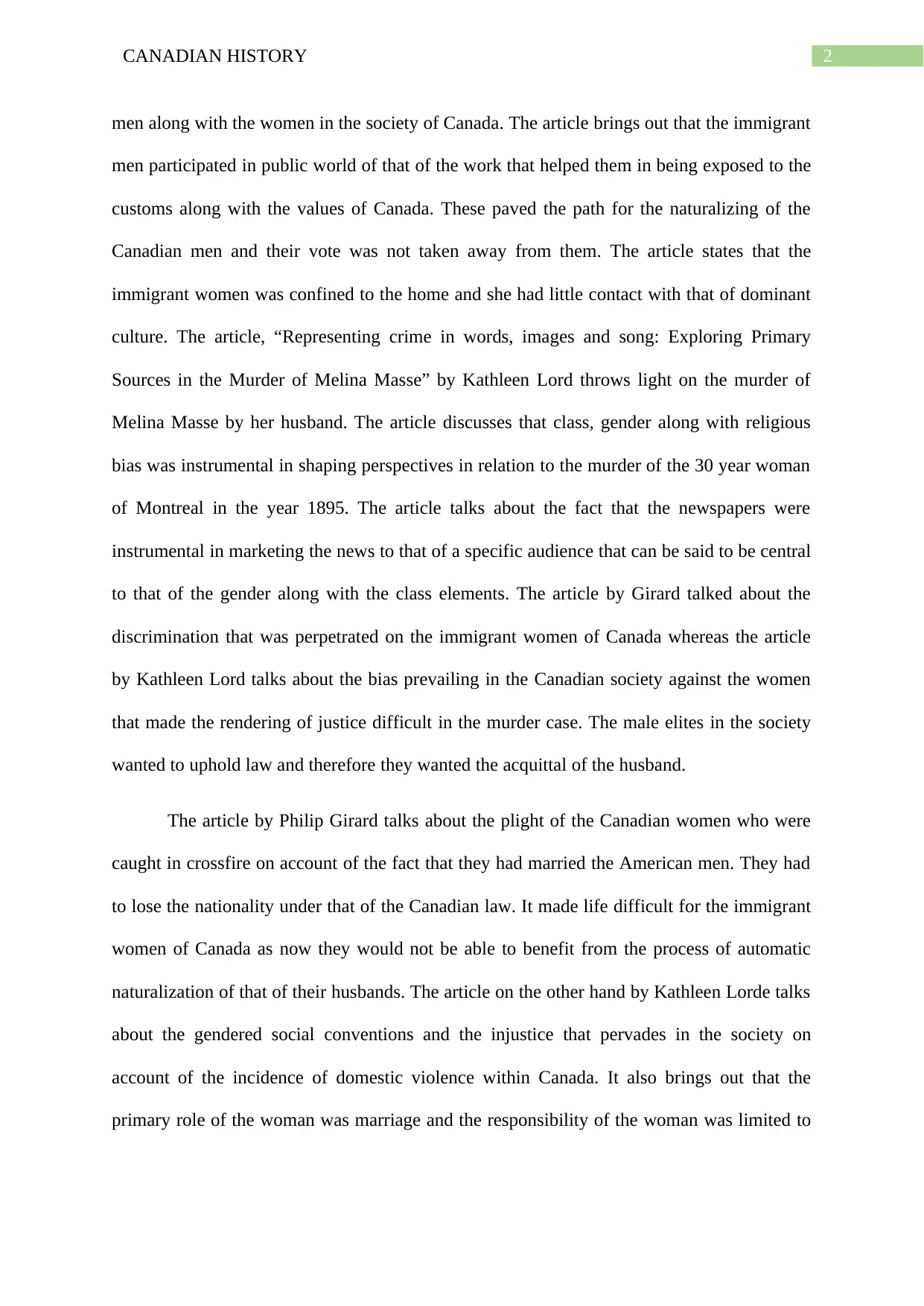
2CANADIAN HISTORY
men along with the women in the society of Canada. The article brings out that the immigrant
men participated in public world of that of the work that helped them in being exposed to the
customs along with the values of Canada. These paved the path for the naturalizing of the
Canadian men and their vote was not taken away from them. The article states that the
immigrant women was confined to the home and she had little contact with that of dominant
culture. The article, “Representing crime in words, images and song: Exploring Primary
Sources in the Murder of Melina Masse” by Kathleen Lord throws light on the murder of
Melina Masse by her husband. The article discusses that class, gender along with religious
bias was instrumental in shaping perspectives in relation to the murder of the 30 year woman
of Montreal in the year 1895. The article talks about the fact that the newspapers were
instrumental in marketing the news to that of a specific audience that can be said to be central
to that of the gender along with the class elements. The article by Girard talked about the
discrimination that was perpetrated on the immigrant women of Canada whereas the article
by Kathleen Lord talks about the bias prevailing in the Canadian society against the women
that made the rendering of justice difficult in the murder case. The male elites in the society
wanted to uphold law and therefore they wanted the acquittal of the husband.
The article by Philip Girard talks about the plight of the Canadian women who were
caught in crossfire on account of the fact that they had married the American men. They had
to lose the nationality under that of the Canadian law. It made life difficult for the immigrant
women of Canada as now they would not be able to benefit from the process of automatic
naturalization of that of their husbands. The article on the other hand by Kathleen Lorde talks
about the gendered social conventions and the injustice that pervades in the society on
account of the incidence of domestic violence within Canada. It also brings out that the
primary role of the woman was marriage and the responsibility of the woman was limited to
men along with the women in the society of Canada. The article brings out that the immigrant
men participated in public world of that of the work that helped them in being exposed to the
customs along with the values of Canada. These paved the path for the naturalizing of the
Canadian men and their vote was not taken away from them. The article states that the
immigrant women was confined to the home and she had little contact with that of dominant
culture. The article, “Representing crime in words, images and song: Exploring Primary
Sources in the Murder of Melina Masse” by Kathleen Lord throws light on the murder of
Melina Masse by her husband. The article discusses that class, gender along with religious
bias was instrumental in shaping perspectives in relation to the murder of the 30 year woman
of Montreal in the year 1895. The article talks about the fact that the newspapers were
instrumental in marketing the news to that of a specific audience that can be said to be central
to that of the gender along with the class elements. The article by Girard talked about the
discrimination that was perpetrated on the immigrant women of Canada whereas the article
by Kathleen Lord talks about the bias prevailing in the Canadian society against the women
that made the rendering of justice difficult in the murder case. The male elites in the society
wanted to uphold law and therefore they wanted the acquittal of the husband.
The article by Philip Girard talks about the plight of the Canadian women who were
caught in crossfire on account of the fact that they had married the American men. They had
to lose the nationality under that of the Canadian law. It made life difficult for the immigrant
women of Canada as now they would not be able to benefit from the process of automatic
naturalization of that of their husbands. The article on the other hand by Kathleen Lorde talks
about the gendered social conventions and the injustice that pervades in the society on
account of the incidence of domestic violence within Canada. It also brings out that the
primary role of the woman was marriage and the responsibility of the woman was limited to
⊘ This is a preview!⊘
Do you want full access?
Subscribe today to unlock all pages.

Trusted by 1+ million students worldwide
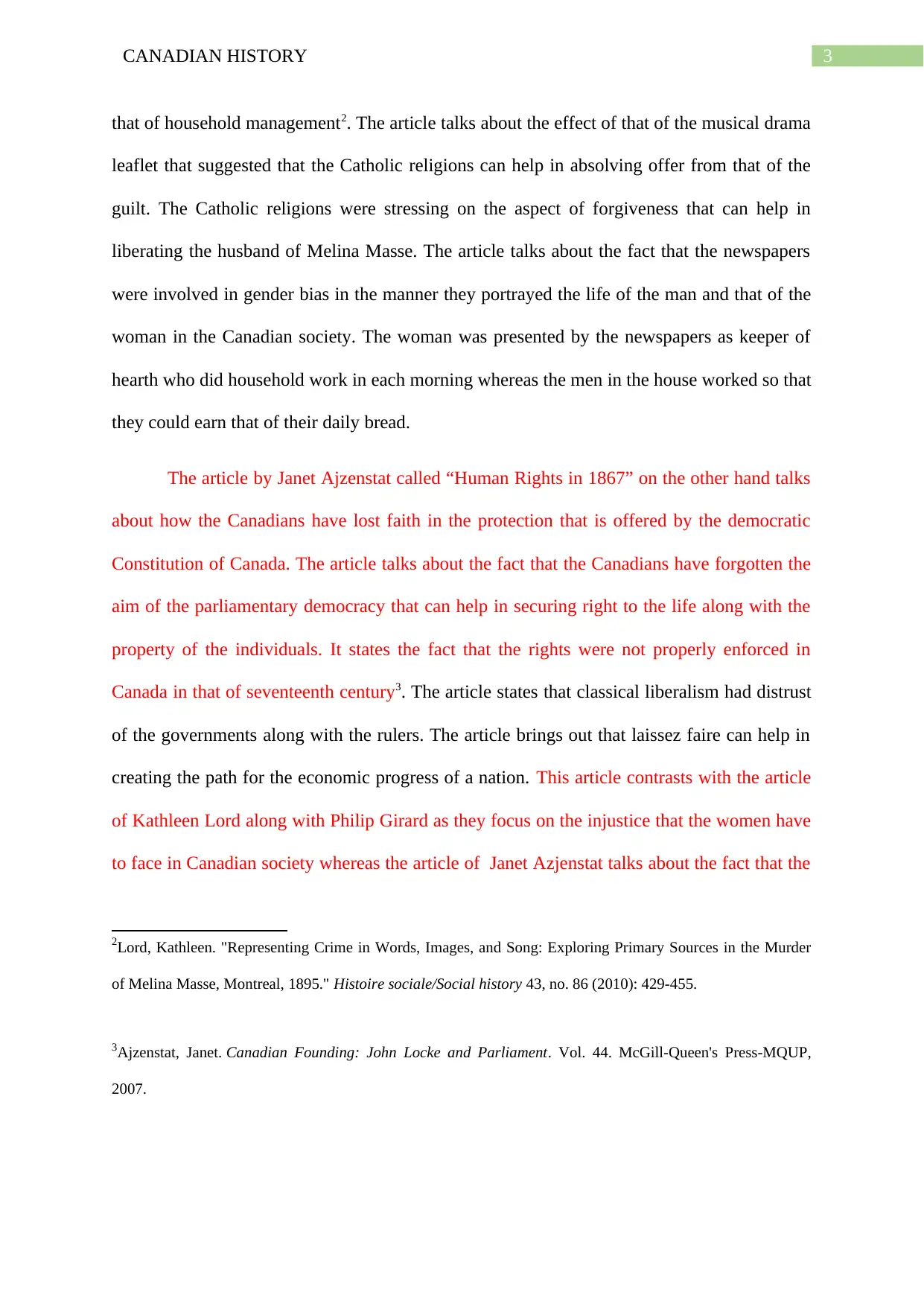
3CANADIAN HISTORY
that of household management2. The article talks about the effect of that of the musical drama
leaflet that suggested that the Catholic religions can help in absolving offer from that of the
guilt. The Catholic religions were stressing on the aspect of forgiveness that can help in
liberating the husband of Melina Masse. The article talks about the fact that the newspapers
were involved in gender bias in the manner they portrayed the life of the man and that of the
woman in the Canadian society. The woman was presented by the newspapers as keeper of
hearth who did household work in each morning whereas the men in the house worked so that
they could earn that of their daily bread.
The article by Janet Ajzenstat called “Human Rights in 1867” on the other hand talks
about how the Canadians have lost faith in the protection that is offered by the democratic
Constitution of Canada. The article talks about the fact that the Canadians have forgotten the
aim of the parliamentary democracy that can help in securing right to the life along with the
property of the individuals. It states the fact that the rights were not properly enforced in
Canada in that of seventeenth century3. The article states that classical liberalism had distrust
of the governments along with the rulers. The article brings out that laissez faire can help in
creating the path for the economic progress of a nation. This article contrasts with the article
of Kathleen Lord along with Philip Girard as they focus on the injustice that the women have
to face in Canadian society whereas the article of Janet Azjenstat talks about the fact that the
2Lord, Kathleen. "Representing Crime in Words, Images, and Song: Exploring Primary Sources in the Murder
of Melina Masse, Montreal, 1895." Histoire sociale/Social history 43, no. 86 (2010): 429-455.
3Ajzenstat, Janet. Canadian Founding: John Locke and Parliament. Vol. 44. McGill-Queen's Press-MQUP,
2007.
that of household management2. The article talks about the effect of that of the musical drama
leaflet that suggested that the Catholic religions can help in absolving offer from that of the
guilt. The Catholic religions were stressing on the aspect of forgiveness that can help in
liberating the husband of Melina Masse. The article talks about the fact that the newspapers
were involved in gender bias in the manner they portrayed the life of the man and that of the
woman in the Canadian society. The woman was presented by the newspapers as keeper of
hearth who did household work in each morning whereas the men in the house worked so that
they could earn that of their daily bread.
The article by Janet Ajzenstat called “Human Rights in 1867” on the other hand talks
about how the Canadians have lost faith in the protection that is offered by the democratic
Constitution of Canada. The article talks about the fact that the Canadians have forgotten the
aim of the parliamentary democracy that can help in securing right to the life along with the
property of the individuals. It states the fact that the rights were not properly enforced in
Canada in that of seventeenth century3. The article states that classical liberalism had distrust
of the governments along with the rulers. The article brings out that laissez faire can help in
creating the path for the economic progress of a nation. This article contrasts with the article
of Kathleen Lord along with Philip Girard as they focus on the injustice that the women have
to face in Canadian society whereas the article of Janet Azjenstat talks about the fact that the
2Lord, Kathleen. "Representing Crime in Words, Images, and Song: Exploring Primary Sources in the Murder
of Melina Masse, Montreal, 1895." Histoire sociale/Social history 43, no. 86 (2010): 429-455.
3Ajzenstat, Janet. Canadian Founding: John Locke and Parliament. Vol. 44. McGill-Queen's Press-MQUP,
2007.
Paraphrase This Document
Need a fresh take? Get an instant paraphrase of this document with our AI Paraphraser
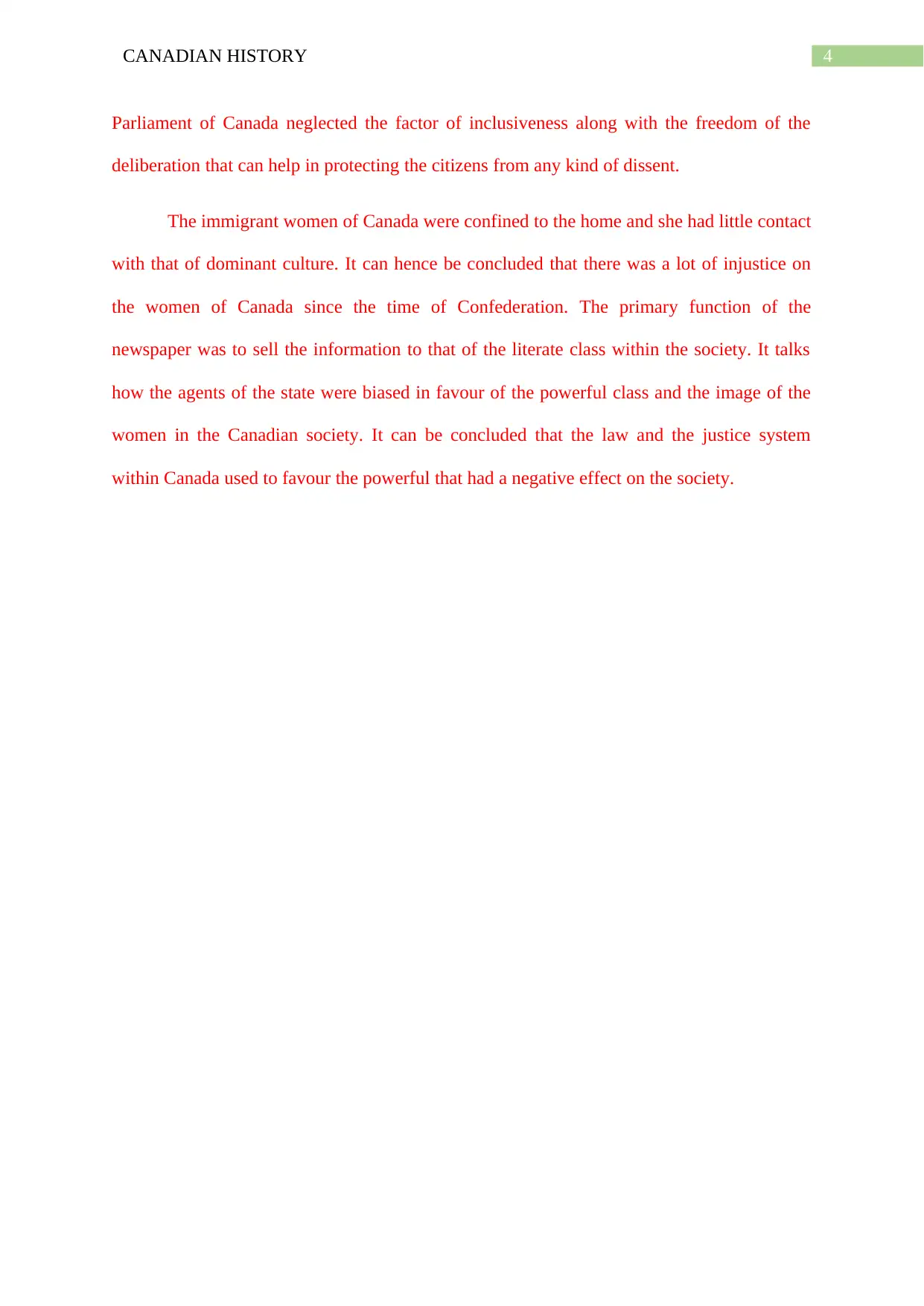
4CANADIAN HISTORY
Parliament of Canada neglected the factor of inclusiveness along with the freedom of the
deliberation that can help in protecting the citizens from any kind of dissent.
The immigrant women of Canada were confined to the home and she had little contact
with that of dominant culture. It can hence be concluded that there was a lot of injustice on
the women of Canada since the time of Confederation. The primary function of the
newspaper was to sell the information to that of the literate class within the society. It talks
how the agents of the state were biased in favour of the powerful class and the image of the
women in the Canadian society. It can be concluded that the law and the justice system
within Canada used to favour the powerful that had a negative effect on the society.
Parliament of Canada neglected the factor of inclusiveness along with the freedom of the
deliberation that can help in protecting the citizens from any kind of dissent.
The immigrant women of Canada were confined to the home and she had little contact
with that of dominant culture. It can hence be concluded that there was a lot of injustice on
the women of Canada since the time of Confederation. The primary function of the
newspaper was to sell the information to that of the literate class within the society. It talks
how the agents of the state were biased in favour of the powerful class and the image of the
women in the Canadian society. It can be concluded that the law and the justice system
within Canada used to favour the powerful that had a negative effect on the society.
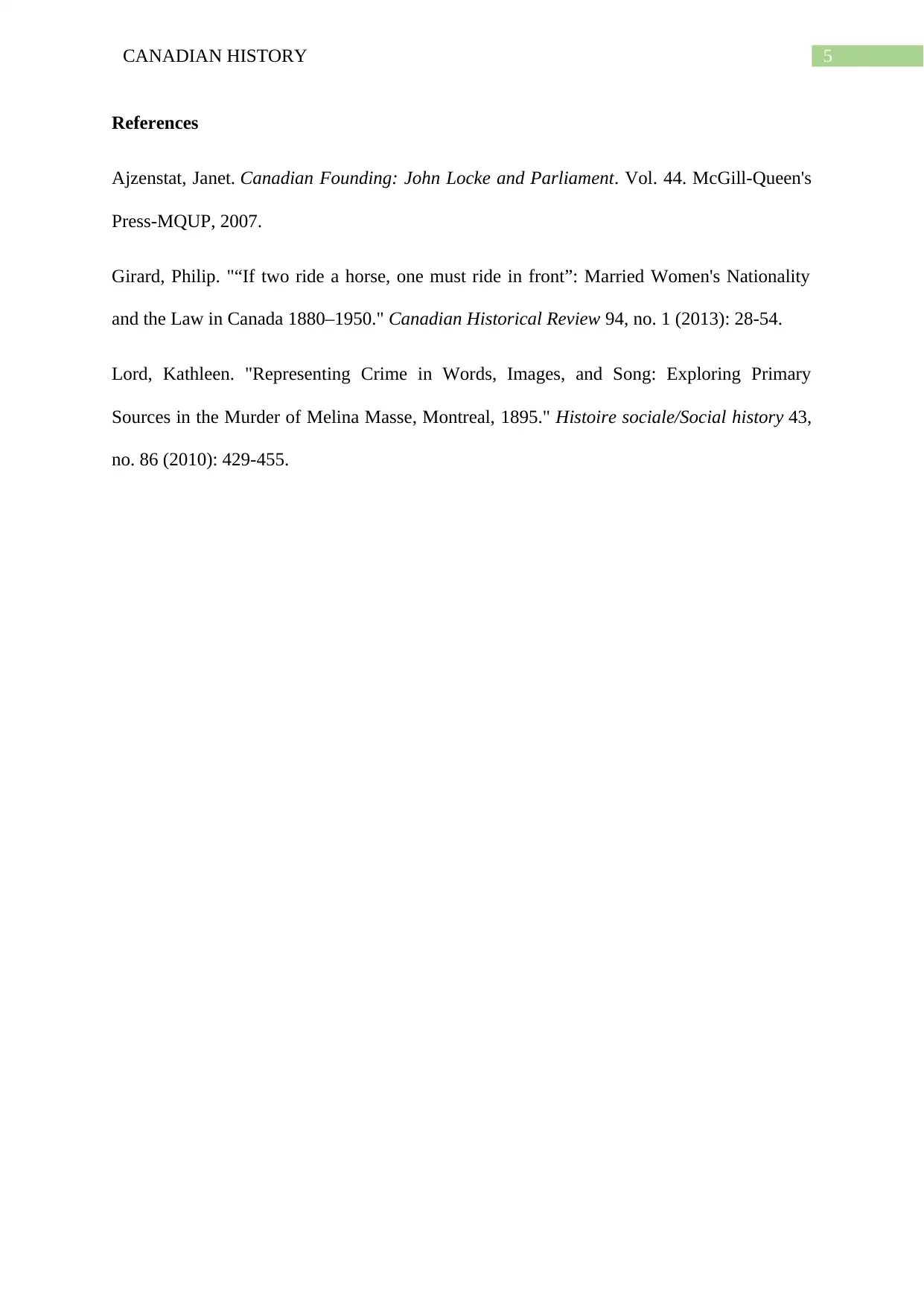
5CANADIAN HISTORY
References
Ajzenstat, Janet. Canadian Founding: John Locke and Parliament. Vol. 44. McGill-Queen's
Press-MQUP, 2007.
Girard, Philip. "“If two ride a horse, one must ride in front”: Married Women's Nationality
and the Law in Canada 1880–1950." Canadian Historical Review 94, no. 1 (2013): 28-54.
Lord, Kathleen. "Representing Crime in Words, Images, and Song: Exploring Primary
Sources in the Murder of Melina Masse, Montreal, 1895." Histoire sociale/Social history 43,
no. 86 (2010): 429-455.
References
Ajzenstat, Janet. Canadian Founding: John Locke and Parliament. Vol. 44. McGill-Queen's
Press-MQUP, 2007.
Girard, Philip. "“If two ride a horse, one must ride in front”: Married Women's Nationality
and the Law in Canada 1880–1950." Canadian Historical Review 94, no. 1 (2013): 28-54.
Lord, Kathleen. "Representing Crime in Words, Images, and Song: Exploring Primary
Sources in the Murder of Melina Masse, Montreal, 1895." Histoire sociale/Social history 43,
no. 86 (2010): 429-455.
⊘ This is a preview!⊘
Do you want full access?
Subscribe today to unlock all pages.

Trusted by 1+ million students worldwide
1 out of 6
Related Documents
Your All-in-One AI-Powered Toolkit for Academic Success.
+13062052269
info@desklib.com
Available 24*7 on WhatsApp / Email
![[object Object]](/_next/static/media/star-bottom.7253800d.svg)
Unlock your academic potential
Copyright © 2020–2025 A2Z Services. All Rights Reserved. Developed and managed by ZUCOL.



